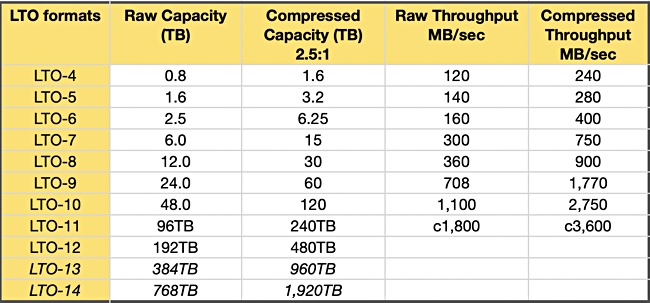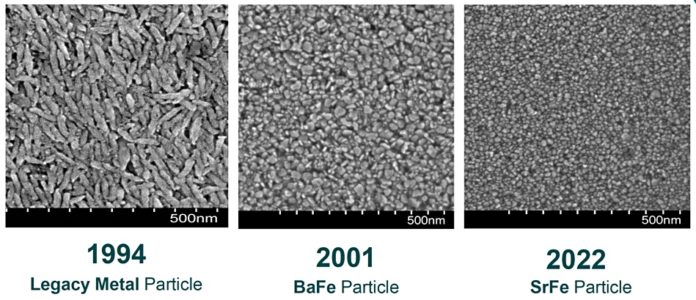Fujifilm reckons it can build a 400TB tape cartridge using Strontium Ferrite (SrFe) media. This is 33 times larger than the current LTO-8 cartridge and takes us out four more LTO generations to 2028 and beyond
We were briefed by Fujifilm on a recent IT Press Tour. Fujifilm is one of just two manufacturers of tape media – Sony is the other – and LTO is the dominant magnetic tape format. Tape is the preferred medium for archive storage – disk costs too much. But data keeps growing. Hence the need for capacity increases.
In 2017, IBM and Sony demoed areal density of 201Gb/in² and 246,200 tracks per inch. This means 330TB tape cartridges are theoretically possible – today’s LTO-8 tapes hold 12TB.
Current magnetic tapes are coated with Barium Ferrite (BaFe) and each LTO generation uses smaller particles formed into narrower data tracks. That results in more capacity per tape reel inside the cartridge. But if BaFe particles get too small a tape drive’s read/write head can no longer reliably read the bit values [magnetic polarity] on the tape. The signal to noise ratio is insufficient.
Step forward, Fujifilm which sees Strontium Ferrite (SrFe) media achieving around 224Gbit/in² area density and 400TB capacity. It says “the majority of the magnetic properties of SrFe are superior to those of BaFe, which will enable us to reach a higher level of performance whilst further reducing the size of the particles.”
If we look at a table of LTO tape generations we see we’re currently on gen 8 (LTO-8) with 96TB raw capacity cartridges. Successive LTO generations generally double capacity. Stream forward to LTO-12 and we have 192TB cartridges.

Fujifilm expects SrFe media to be used in LTO-11 and LTO-12 tape.
The LTO generation gap
Every so often the LTO consortium announces a roadmap extension. The LTO-7 and LTO-8 formats were announced in 2010. In 2014, when LTO-6 was shipping, the consortium announced LTO generations 9 and 10. The Register envisaged an LTO-11 in 2015 and the actual LTO-11 and LTO-12 generations were announced in October 2017.
Blocks & Files expects the LTO consortium, by the end of 2021, to extend its roadmap beyond LTO-12, based on this roadmap extension history. Continuing the capacity doubling per generation progression we have seen so far, so a potential LTO-13 would have 384TB capacity.
A suggested LTO-14 would have 768TB capacity, beyond Fujifilm’s 400TB SrFE media cartridge. If we care to project further, an LTO-15 would have a 1.53PB capacity.
Blocks & Files thinks Fujifilm may need a post-Strontium Ferrite technology one generation past LTO-13.
When will that be? Assume two years to three years; say 2.5 years between LTO generations with LTO-8 shipping in 2019. We’ll see LTO-12 in 2030 and LTO-13, if it happens, in 2032/33.
Areal density headroom
How far can tape areal density improvements go?
We will use HDDs as a reference point, since that technology also stores magnetised bits in a recording medium layer deposited on a substrate; a platter in contrast to a tape ribbon.
Maximum HDD areal density is in the 700 Gbits/in² or greater area, with some drives having far higher areal density. A Seagate Skyhawk AI disk achieving 867 Gbits/in². Toshiba’s 2.5-inch MQ01 stores data at a higher density still; 1.787 Tbits/in². Put another way, HDD bits are a lot smaller than tape bits.
This implies tape media areal density improvements have a lot of headroom before they reach the current state of play in disk recording media material.
The actual read-write head technology is roughly equivalent between disk and tape. Since disk read/write heads can read and write such small bits then, in theory, tape read and write heads could do the same. So, we can keep on throwing more and more old data at tape archives and the technology will keep up.







